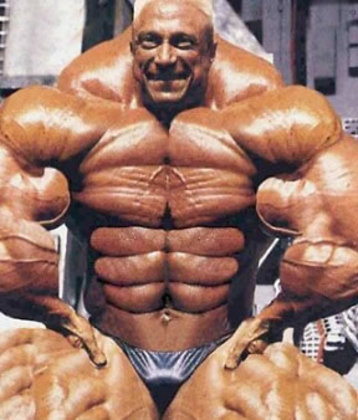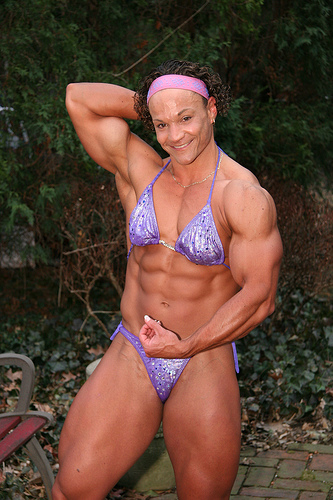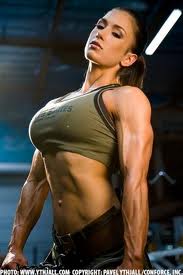 |
ช่วงนี้กำลังยุ่ง ไม่มีเวลาค้นอ้างอิงแบบเนี้ยบๆและแปลให้ ถ้าใครรู้มาไม่เหมือนผมกรุณาแย้งด้วย ถ้ามีอ้างอิงจะเป็นพระคุณอย่างสูง เว็บที่เอามาเนี่ยไม่วิชาการสักเท่าไหร่ ตอนแรกไม่กล้าเอามาแปะ แต่พอดูชื่อในวงเล็บเป็นชื่อของเจ้าแม่ Physio (Elaine N. Marieb) เลยคิดว่าเขาน่าจะ quote มาจาก textbook ก็น่าจะพอ ok นะครับ
เท่าที่ผมทราบ การที่นักเพาะกายมีกล้ามเนื้อใหญ่ขึ้นจากการฝึกเกิดจากการพยายามซ่อมแซมภาวะ micro tear ที่เกิดจากการยกน้ำหนักมากๆสัก 80-90 % ของ 1 RM (Repetition Maximum น้ำหนักสูงสุดที่คุณยกได้ 1 ครั้ง ถ้าเป็น 10RM ก็คือ น้ำหนักสูงสุดที่คุณยกได้ 10 ครั้ง) ทำให้เกิด cross-sectional area (CSA) เพิ่มขึ้น อันนี้ที่ไปค้นมาให้ก็เน้นเรื่องนี้เหมือนกัน
Physiology of Muscle Growth
(http://www.bodybuilding.com/fun/muscle-hypertrophy-physiology-how-to-lift-weights-maximize-mass.htm)
When muscles are used they adapt and change. Changes are dependent on the type of activity and muscle fiber types used, the load exerted on the muscle, and the velocity and duration of the contraction (Marieb, 2004).
Muscle growth, also referred to as muscle hypertrophy, is an example of muscular adaptations and changes.
Muscle hypertrophy occurs primarily through chronic anaerobic, high-intensity resistance activity, like that which happens during resistance training lifting weights (Brown, McCartney & Sale, 1990; Cureton, Collins, Hill, & McElhannon, 1988; Marieb, 2004; McCall, Byrnes, Dickenson, Pattany, & Fleck, 1996).
Resistance training causes neural adaptations, which result in changes in muscular endurance and muscular strength, and eventually, the size of the muscles (Fleck & Kraemer, 2004).
ใจความสำคัญที่คุณอยากรู้คือย่อหน้าต่อไปนี้ครับ
Resistance training causes an increase in the cross-sectional area (CSA) of all muscle fiber types (Brown, et al., 1990; Cureton, et al., 1988; Holm, et al., 1991; McCall, et al., 1996; Widrick, Stelzer, Shoepe & Garner, 2002), without an increase in muscle fiber numbers (McCall, et al., 1996).
Age and sex have been shown to influence the degree to which hypertrophy occurs in an individual (Martel, et al., 2005).
นอกจากขนาดของกล้ามเนื้อแล้ว นักกีฬาแต่ละนิดก็จะมีปริมาณของกล้ามเนื้อที่เหมาะกับชนิดของกีฬาต่างกันไป
Muscle Fibers and Types
1. Slow Oxidative Fibers (นักวิ่งมาราธอน ทางไกลๆ ผอมๆแห้ง)
Slow oxidative fibers are commonly referred to as Type I muscle fibers. These muscle fibers are recruited first during activity, contracting slowly due to slow Myosin ATPase activity. Although Type I fibers have a high Myoglobin content, they contain low glycogen levels, using aerobic glycolysis for Adenosine Triphosphate (ATP) (i.e. energy) synthesis.
A high oxidative capacity, due to the many capillaries and mitochondria that they contain, allows them to have a very slow rate of fatigue, therefore making them best suited for endurance activities such as distance running (Marieb, 2004).
2. Fast Oxidative Fibers (นักวิ่งระยะสั้น)
Fast oxidative fibers, also called Type IIa muscle fibers, are recruited second during exercise. Like Type I fibers Type IIa fibers have high Myoglobin content and many capillaries and mitochondria. However, instead of low glycogen stores, their glycogen content is moderate, causing them to be moderately fatigue resistant.
Alongside this, they have fast contractile speeds and Myosin ATPase activity, therefore making them best suited for activities that use both the anaerobic Glycolysis and aerobic Glycolysis energy systems, such as sprinting (Marieb, 2004).
3. Fast Glycolytic Fibers (นักยกน้ำหนัก กล้ามโตๆ)
Fast glycolytic fibers, the Type IIb muscle fibers, do not use oxygen for fuel, and are recruited third during activity. Type IIb fibers have few capillaries and mitochondria and low Myoglobin content. Although Type IIb fibers depend entirely on glycogen for fuel, despite having high glycogen stores, they fatigue quickly. This coupled with their powerful contractile ability and fast Myosin ATPase activity make them best suited for short-term intense or powerful movements, such as used in resistance training (Marieb, 2004).
ถ้าคุณ จขกท อยากได้แบบละเอียดๆกว่านี้ให้ลองถามอากู๋ Physiology of exercise ดูละกันครับ เรื่องนี้มีเป็น textbook เลยล่ะ ถ้าอยากได้อ้างอิงเจ๋งๆแบบไม่ใช่หมอก็อ่านได้แต่ควรมีความรู้บ้างแบบนักกีฬาหรือโค้ชแนะนำของ ACSM ครับ
| จากคุณ |
:
Doctor-K (Devamorana) 
|
| เขียนเมื่อ |
:
28 ต.ค. 53 19:05:13
|
|
|
|
 |









